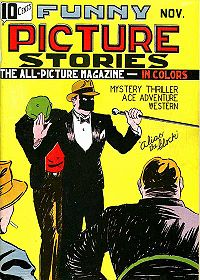- Clock (comics)
-
The Clock 
Funny Picture Stories #1 (Nov, 1936). Comic Magazine Company.Publication information Publisher Comic Magazine Company
Ultem
Quality ComicsFirst appearance Funny Pages #6 or Funny Picture Stories #1; November 1936 Created by George Brenner In-story information Alter ego Brian O'Brien Partnerships Pug Brady
ButchThe Clock is a fictional masked crime-fighter published during the Golden Age of Comic Books. According to the Overstreet Comic Book Price Guide, the Clock was the first masked hero to appear in American comic books.
Publication history
Created by cartoonist George Brenner, the character first appeared in either Funny Pages #6 or Funny Picture Stories #1, each cover-dated November 1936 and published by the Comics Magazine Company, the primary forerunner of Centaur Publications.
The character's initial appearances were two-page features that left little space for character development, but the Clock's secret identity was eventually revealed to be society man and former district attorney Brian O'Brien, whose background in college sports helped prepare him for heroism.
The Clock could be considered the “missing link” between pulp and comic book heroes. His secret identity is that of Brian O'Brien, a wealthy member of high society and a former lawyer. He had a secret, underground and was a hypnotist. His minimalist costume was a three-piece suit and a mask and he was a master of disguise. He had clever gadgets (such as a cane whose head becomes a projectile and a diamond stud that fires teargas) and he usually left behind a calling card bearing the image of a clock-face and the words "The Clock Has Struck."
The Clock appeared in Funny Pages #6-11, as well as other titles by the Comics Magazine Company, such as Detective Picture Stories and Keen Detective Funnies. In 1937, the Comics Magazine Company was bought by a company Ultem, which then encountered financial difficulty and sold the Clock and other characters to Quality Comics. Ultem was itself subsequently purchased and renamed Centaur Publications. Despite the sale to Quality, the company continued to reprint old Clock stories.
Under Quality, the Clock continued to be written and drawn in new stories by Brenner in Feature Funnies (later retitled Feature Comics) beginning with #3 (Dec., 1937) and running through #31 (April 1940). It is believed that Quality editor Will Eisner was in part inspired by this run of the Clock to create the Spirit. The Clock's feature was moved to the new Crack Comics #1 (May 1940).
When Centaur sold the Clock to Quality, the powers-that-be decided he needed a sidekick to soften him up. At first he was assisted by Pat "Pug" Brady, a former boxer who looked exactly like Brian O'Brien. They met when they picked each other's pockets in Crack Comics #1. Pug's disguise was even more minimal than that of his boss—a handkerchief worn like a cowboy bandit wears a bandanna. The first time he worked with the Clock, he found out his secret identity and killed somebody else who found it out, so it didn't soften the Clock's image by much.
In Crack Comics #21, Pug disappeared with no explanation, which may be why the Clock got himself all shot up and crawled into a basement to die. Fortunately for him, a young girl named Butch Buchanan was squatting in that same basement and nursed him back to health. She attached herself to him as his "moll" and evidently convinced him to wear a knockoff of the Spirit's costume from issue #22 on.
The Clock alternated appearances on the cover of Crack Comics with the Black Condor until #19, continuing as only a backup feature of that title until his final appearance in Crack Comics #35 (Autumn 1944).
After Quality Comics went out of business in 1956, DC Comics acquired the rights to its characters. However, it didn't renew the copyright for most of the characters in question (including the Clock), allowing them to fall into public domain. The company has never made use of the Clock beyond a few mere mentions. In the DC Universe, the Clock was initially said to have been killed in 1944, the last year his character was actually published. The journal of the character the Shade revealed, in Starman Vol. 2, #19, that "Brian O'Brien told me the reports of his death were greatly exaggerated". Starman #20 then stated O'Brien was active in Chicago, despite the fact that several Golden Age adventures stated that his home city was a seaport. Perhaps these adventures took place on the now-retconned Earth-Two, former home of DC's Golden Age characters.
Other versions
In 1992, Malibu Comics published 20 issues of The Protectors, a superhero team that included several other characters from the Centaur line. In this universe, Brian O'Brien was the first costumed hero. With the advent of super-powered heroes, he decided to give up crime-fighting, choosing instead to join the army. He rose through the ranks and eventually became President of the United States.
External links
- On-Line Reprint of a Clock Adventure
- Eye-n-Apple's Golden Age Gallery page on the Clock
- Toonopedia page on the Clock
Categories:- Comics characters introduced in 1936
- DC Comics superheroes
- Fictional lawyers
- Golden Age superheroes
- Protectors characters
- Quality Comics superheroes
- Quality Comics titles
Wikimedia Foundation. 2010.

